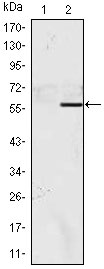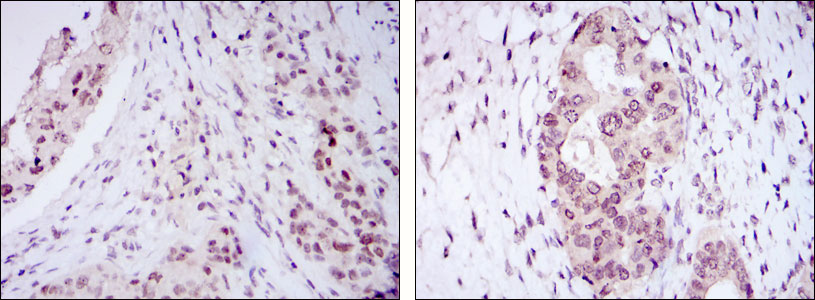NACC1 Antibody
Purified Mouse Monoclonal Antibody
- SPECIFICATION
- CITATIONS
- PROTOCOLS
- BACKGROUND

Application
| WB, IHC, E |
|---|---|
| Primary Accession | Q96RE7 |
| Reactivity | Human |
| Host | Mouse |
| Clonality | Monoclonal |
| Clone Names | 6H2 |
| Isotype | IgG1 |
| Calculated MW | 58kDa |
| Description | NAC1 or nuclear accumbens-1 is a nuclear factor that belongs to the POZ/BTB (Pox virus and zinc finger/bric-a-brac tramtrack broad complex) domain family. Also known as BTBD14B, it was originally identified in a unique neuronal forebrain structure responsible for reward motivation and addictive behaviors . NAC1 recruits HDAC3 and HDAC4 to transcriptionally repress gene expression in neuronal cells (3) and specifically co-represses other POZ/BTB proteins in the central nervous system . NAC1 is upregulated in several tumor types, including breast, renal cell, and hepatocellular carcinoma, as well as high grade ovarian serous carcinoma, where it has long been suspected as a chemoresistance gene . The chemoresistance mechanism reportedly occurs through NAC1 negative regulation of the GADD45 pathway . NAC1 has also been described as part of the extended transcriptional network in pluripotent cells that involves Oct-4, Sox2, Nanog, Sall1, KLF4 and Sall4 . Tissue specificity: Overexpressed in several types of carcinomas including ovarian serous carcinomas. Expression levels positively correlate with tumor recurrence in ovarian serous carcinomas, and intense immunoreactivity in primary ovarian tumors predicts early recurrence. Up-regulated in ovarian carcinomas after chemotherapy, suggesting a role in development of chemotherapy resistance in ovarian cancer . |
| Immunogen | Purified recombinant fragment of human NACC1 expressed in E. Coli. |
| Formulation | Ascitic fluid containing 0.03% sodium azide. |
| Gene ID | 112939 |
|---|---|
| Other Names | Nucleus accumbens-associated protein 1, NAC-1, BTB/POZ domain-containing protein 14B, NACC1, BTBD14B, NAC1 |
| Dilution | WB~~1/500 - 1/2000 IHC~~1/200 - 1/1000 |
| Storage | Maintain refrigerated at 2-8°C for up to 6 months. For long term storage store at -20°C in small aliquots to prevent freeze-thaw cycles. |
| Precautions | NACC1 Antibody is for research use only and not for use in diagnostic or therapeutic procedures. |
| Name | NACC1 |
|---|---|
| Synonyms | BTBD14B, NAC1 |
| Function | Functions as a transcriptional repressor. Seems to function as a transcriptional corepressor in neuronal cells through recruitment of HDAC3 and HDAC4. Contributes to tumor progression, and tumor cell proliferation and survival. This may be mediated at least in part through repressing transcriptional activity of GADD45GIP1. Required for recruiting the proteasome from the nucleus to the cytoplasm and dendritic spines. |
| Cellular Location | Nucleus. Cytoplasm. Note=Distribution in the cytoplasm is dependent on phosphorylation. |
| Tissue Location | Overexpressed in several types of carcinomas including ovarian serous carcinomas. Expression levels positively correlate with tumor recurrence in ovarian serous carcinomas, and intense immunoreactivity in primary ovarian tumors predicts early recurrence. Up-regulated in ovarian carcinomas after chemotherapy, suggesting a role in development of chemotherapy resistance in ovarian cancer. |

Thousands of laboratories across the world have published research that depended on the performance of antibodies from Abcepta to advance their research. Check out links to articles that cite our products in major peer-reviewed journals, organized by research category.
info@abcepta.com, and receive a free "I Love Antibodies" mug.
Provided below are standard protocols that you may find useful for product applications.
References
1. Neuroscience. 2002;110(3):421-9. 2. Proc Natl Acad Sci U S A. 2004 Aug 17;101(33):12130-5.
If you have used an Abcepta product and would like to share how it has performed, please click on the "Submit Review" button and provide the requested information. Our staff will examine and post your review and contact you if needed.
If you have any additional inquiries please email technical services at tech@abcepta.com.













 Foundational characteristics of cancer include proliferation, angiogenesis, migration, evasion of apoptosis, and cellular immortality. Find key markers for these cellular processes and antibodies to detect them.
Foundational characteristics of cancer include proliferation, angiogenesis, migration, evasion of apoptosis, and cellular immortality. Find key markers for these cellular processes and antibodies to detect them. The SUMOplot™ Analysis Program predicts and scores sumoylation sites in your protein. SUMOylation is a post-translational modification involved in various cellular processes, such as nuclear-cytosolic transport, transcriptional regulation, apoptosis, protein stability, response to stress, and progression through the cell cycle.
The SUMOplot™ Analysis Program predicts and scores sumoylation sites in your protein. SUMOylation is a post-translational modification involved in various cellular processes, such as nuclear-cytosolic transport, transcriptional regulation, apoptosis, protein stability, response to stress, and progression through the cell cycle. The Autophagy Receptor Motif Plotter predicts and scores autophagy receptor binding sites in your protein. Identifying proteins connected to this pathway is critical to understanding the role of autophagy in physiological as well as pathological processes such as development, differentiation, neurodegenerative diseases, stress, infection, and cancer.
The Autophagy Receptor Motif Plotter predicts and scores autophagy receptor binding sites in your protein. Identifying proteins connected to this pathway is critical to understanding the role of autophagy in physiological as well as pathological processes such as development, differentiation, neurodegenerative diseases, stress, infection, and cancer.



